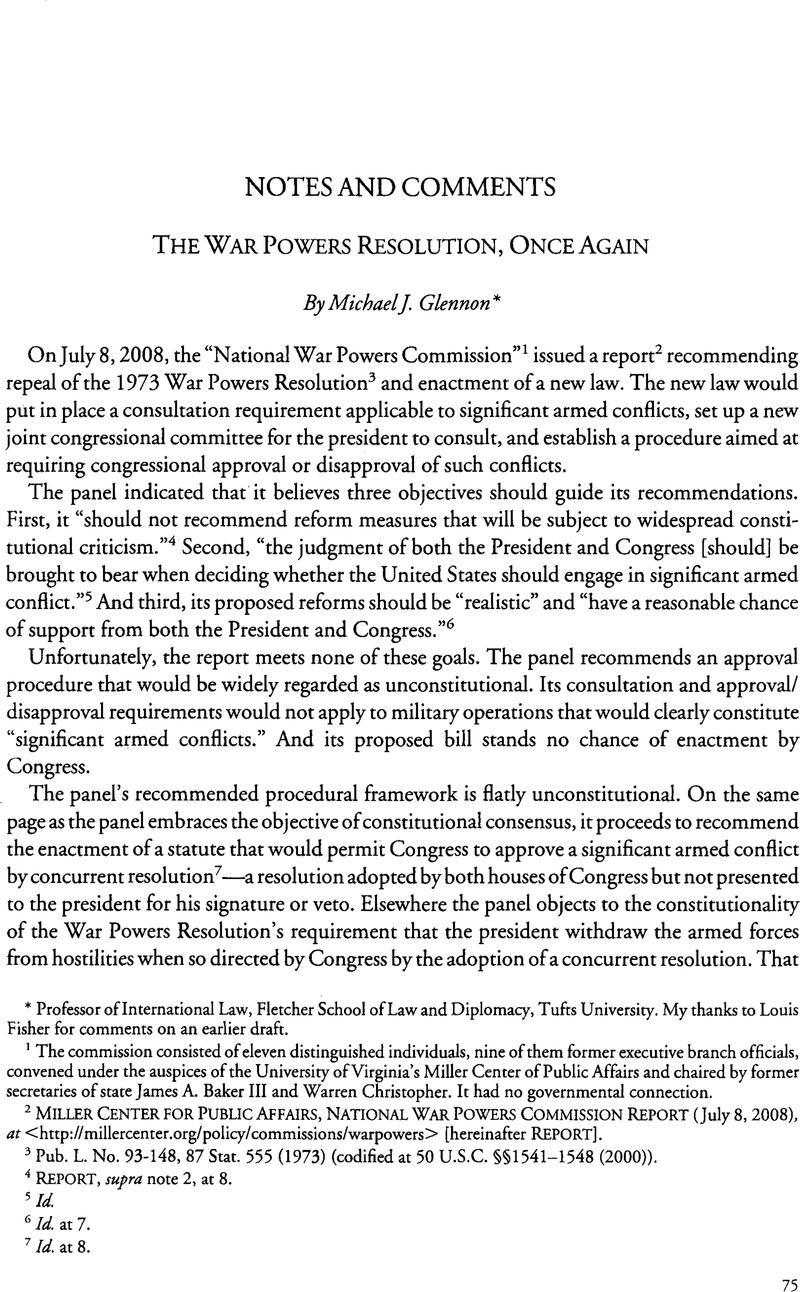Article contents
The War Powers Resolution, Once Again
Published online by Cambridge University Press: 27 February 2017
Abstract

- Type
- Notes and Comments
- Information
- Copyright
- Copyright © American Society of International Law 2009
References
1 The commission consisted of eleven distinguished individuals, nine of them former executive branch officials, convened under the auspices of the University of Virginia’s Miller Center of Public Affairs and chaired by former secretaries of state James A. Baker III and Warren Christopher. It had no governmental connection.
2 Miller Center For Public Affairs, National War Powers Commission Report (July 8, 2008), at <http://millercenter.org/policy/commissions/warpowers [hereinafter Report].Google Scholar
3 Pub. L. No. 93–148, 87 Stat. 555 (1973) (codified at 50 U.S.C. §§1541–1548 (2000)).
4 Report, supra note 2, at 8.
5 Id.
6 Id. at 7.
7 Id. at 8.
8 INS v. Chadha, 462 U.S. 919 (1983).
9 Report, supra note 2, at 23.
10 Id. at 36.
11 Id.
12 U.S. Dep’t of State, State Sponsors of Terrorism, at <http://www.state.gov/s/ct/cl4151. htm. North Korea was removed from the list in late 2008.
13 Section 15 of the Act of Aug. 1, 1956, amended by Pub. L. No. 92–226, pt. IV, §407(b), 86 Stat. 35 (1972) (codified at 22 U.S.C. §2680(b) (2006)).
14 One is “irrational consistency,” the tendency of decision makers to ground conclusions upon previously formed images of reality, resulting in cognitive dissonance that causes a selective processing of information to conform to those presuppositions. See generally jEdwin, M. Smith Congressional Authorization of Nuclear First Use: Problems of Implementation, in First Use of Nuclear Weapons: Under The Constitution, Who Decides? 169, 187 (Raven–Hansen, Peter ed., 1987)Google Scholar. Another is “defensive avoidance,” an effort of decision makers to reduce the stress that derives from uncertainty by unconsciously exaggerating the attractiveness of one or more options, thus denying responsibility for making the wrong choice. See Robert, Jervis Perception and Misperception in International Politics 145–46 (1976)Google Scholar. A third is “groupthink,” a phenomenon of group dynamics that stifles the full discussion of all alternatives open to highly cohesive groups constrained by unarticulated premises of loyalty and consistency. See generally Irving, L. Janis Groupthink: Psychological Studies of Policy Decisions and Fiascoes (2d rev. ed. 1983)Google Scholar.
15 Report, supra note 2, at 30.
16 Id. at 24.
17 Presidential Power to Use the Armed Forces Abroad Without Statutory Authorization, 4A Op. Off. Legal Counsel 185, 196 (1980), 1980 OLC lexis 13.
18 The author served as co–counsel to the congressional plaintiffs in Lowry v. Reagan, 676 F.Supp. 333 (D.D.C. 1987), aff’d, No. 87–5426 (D.C. Cir. Oct. 1, 1988) (per curiam).
19 Report, supra note 2, at 19.
20 Dellums v. Bush, 752 F.Supp. 1141 (D.D.C. 1990).
21 M at 1145.
22 Report, supra note 2, at 24.
23 Id. at 14.
24 Louis, Fisher The “Sole Organ“ Doctrine 7 (Law Library of Congress, Studies on Presidential Power in Foreign Relations No. 1, Aug. 28, 2006), at <http://www.fas.org/sgp/eprint/fisher.pdf.Google Scholar
25 The panel’s recommended bill does not provide, as does section 8(d)(2) of the War Powers Resolution, that nothing in it may be construed as conferring any war–making authority upon the president that he would not have had in its absence.
26 Report, supra note 2, at 39.
27 Youngstown Sheet & Tube Co. v. Sawyer, 343 U.S. 579, 637 (1952) (Jackson, J., concurring).
28 Report, supra note 2, at 8.
29 50 U.S.C. §1547(2000).
30 S. Rep. No. 93–220, at 25 (1973).
31 Orlando v. Laird, 443 F.2d 1039, 1043 (2d Cir. 1971).
32 Report, supra note 2, at 39.
33 Id.
34 U.S. Const. Art. I, §5, cl. 2.
35 The author served as special counsel to the subcommittee.
36 The bill was introduced most recently as the Use of Force Act, S. 2387, 105th Cong. (1998).
37 H.R.J. Res. 53, 110th Cong. (2007).
38 The author was a member.
39 The Constitution Project, Deciding To Use Force Abroad: War Powers in a System Of Checks and Balances (2005), at <http://www.constitutionproject.org/pdf/War_Powers_Deciding_To_Use_Force_Abroad.pdf.Google Scholar
40 The proposed procedure, while novel, is not entirely new. On May 15, 1978, the Senate Foreign Relations Committee reported a measure, S. 3076, 95th Cong. §502 (1978), that would have subjected an unauthorized agreement to a point–of–order procedure that would have cut off funds for the implementation of the agreement in question, but the measure was rejected by the full Senate. (Section 502 incorporated the Treaty Powers Resolution, S. Res. 24, 95th Cong. (1978).) The same measure, sponsored by Senators Dick Clark, Frank Church, Edward Kennedy, and Walter Mondale, had been introduced in 1976 as S. Res. 486, 94th Cong. (1976). Hearings were held on the measure by the Senate Foreign Relations Committee on July 21 and 28, 1976.
41 See Ely, John Hart Suppose Congress Wanted a War Powers Act That Worked , 88 Colum. L. Rev. 1379 (1988)CrossRefGoogle Scholar. For the argument that the use of force in Iraq is unconstitutional and an analysis of the political reasons that Congress does nothing about it, see Michael, J. Glennon A Conveniently Unlawful War , Pol’y Rev., Aug./Sept. 2008, at 75,Google Scholar available at <http://www.hoover.org/publications/policyreview/26119169.html.
- 3
- Cited by




